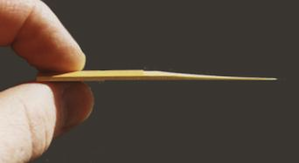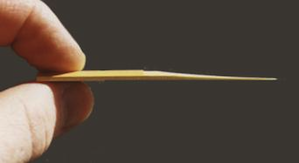
Yes, the best reeds will play great right out of the box. However, there is a “breaking in period” for a new reed. Practicing away on a brand new reed could end up just killing it. Here are some tips for breaking in a reed so it will last:
On Day 1, simply test the reed by playing it for no longer than five minutes. Always moisten the entire reed in your mouth, from heel to tip, before playing. Observe its qualities, such as how easily it vibrates, its responsiveness and level of resistance to your air, and the quality of tone it produces. Play only at a soft to medium volume and avoid altissimo register notes on the first playing. It is a good idea to number the reed and make some notes to yourself in pencil on the back of the reed heel, such as “soft”, “hard”, “easy”, “fuzzy”, Smiley Face, Sad Face, etc. It is a good idea to come up with your own system for keeping track of your reeds.
Prior to putting the reed away to dry, use your thumb to gently rub the vamp of the reed by stroking in the direction of the grain (from heel to tip) to smooth out pores in the fibers.
Store the reed on a flat surface or in a reed case and let it dry completely before using it again. Do not store reeds in the plastic cases that they come in. These are not completely flat and can warp wet reeds. Invest in a reed case in which to store your reeds.
On the next two days, increase slightly the amount of time you play on the reed, and play a little louder and a little higher in the register each day, but do not play for longer than 15 minutes. Let the reed dry completely again on a flat surface between uses. Continue to observe the reed’s qualities. The best reeds will feel good from the start.
On days four through six play the reed for a bit longer, louder, and higher in the register, gradually working up to playing it for about an hour at a time by day seven.
Always have at least 4 good reeds in your reed case that have been broken in completely, and rotate through them for each practice session. Do not play the same reed for hours at a time or for several practice sessions in a row, as overuse will crush the fibers and decrease its lifespan.
As you notice your old reeds starting to lose their luster, immediately begin the process of breaking in several new reeds so that you have enough time to add them into your rotation before your old reeds die. This guarantees you will always have several good reeds you know you can trust at any given time.
A carefully broken-in reed can easily provide 40-60 or more total playing hours in its lifespan, if rotated regularly and not overplayed. I’ve had reeds last for months and months in this way, and can often make my best reeds last seemingly forever.
Reeds that still don’t feel good after breaking in are probably duds. While techniques such as sanding or shaving may do a little to improve the balance of the tip or response of a bad reed, no amount of sanding will improve the quality of poor cane or a poorly cut piece of cane. Every box of reeds has a few winners, and a few duds. By taking the time to break in your reeds, you can get the most out of your good reeds and make the winners really last.

